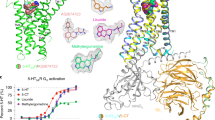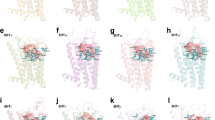Abstract
The clinical use of currently available drugs acting at the5-HT4 receptor has been hampered by their lack of selectivityover 5-HT3 binding sites. For this reason, there is considerableinterest in the medicinal chemistry of these serotonin receptor subtypes, andsignificant effort has been made towards the discovery of potent and selectiveligands. Computer-aided conformational analysis was used to characterizeserotoninergic 5-HT3 and 5-HT4 receptorrecognition. On the basis of the generally accepted model of the5-HT3 antagonist pharmacophore, we have performed a receptormapping of this receptor binding site, following the active analog approach(AAA) defined by Marshall. The receptor excluded volume was calculated as theunion of the van der Waals density maps of nine active ligands(pKi ≥ 8.9), superimposed in pharmacophoric conformations.Six inactive analogs (pKi < 7.0) were subsequently used todefine the essential volume, which in its turn can be used to define theregions of steric intolerance of the 5-HT3 receptor. Five activeligands (pKi ≥ 9.3) at 5-HT4 receptors wereused to construct an antagonist pharmacophore for this receptor, and todetermine its excluded volume by superimposition of pharmacophoricconformations. The volume defined by the superimposition of five inactive5-HT4 receptor analogs that possess the pharmacophoric elements(pKi ≤ 6.6) did not exceed the excluded volume calculated forthis receptor. In this case, the inactivity may be due to the lack of positiveinteraction of the amino moiety with a hypothetical hydrophobic pocket, whichwould interact with the voluminous substituents of the basic nitrogen ofactive ligands. The difference between the excluded volumes of both receptorshas confirmed that the main difference is indeed in the basic moiety. Thus,the 5-HT3 receptor can only accommodate small substituents inthe position of the nitrogen atom, whereas the 5-HT4 receptorrequires more voluminous groups. Also, the basic nitrogen is located at ca.8.0 Å from the aromatic moiety in the 5-HT4 antagonistpharmacophore, whereas this distance is ca. 7.5 Å in the5-HT3 antagonist model. The comparative mapping of bothserotoninergic receptors has allowed us to confirm the three-componentpharmacophore accepted for the 5-HT3 receptor, as well as topropose a steric model for the 5-HT4 receptor binding site. Thisstudy offers structural insights to aid the design of new selective ligands,and the resulting models have received some support from the synthesis of twonew active and selective ligands: 24 (Ki(5-HT3)= 3.7 nM; Ki(5-HT4) > 1000 nM) and 25(Ki(5-HT4) = 13.7 nM;Ki(5-HT3) > 10 000 nM).
Similar content being viewed by others
References
Humphrey, P.P.A., In Langer, S.Z., Brunello, N., Racagni, G. and Mendlewicz, J. (Eds.), Serotonin Receptor Subtypes: Pharmacological Significance and Clinical Implications, Vol. 1, Karger, Basel, Switzerland, 1992, pp. 129–139.
Teitler, M., Med. Chem. Res., 3 (1993) 273.
Herndon, J.L. and Glennon, R.A., In Kozikowski, A.P. (Ed.), Drug Design for Neuroscience, Raven Press, New York, NY, U.S.A., 1993, pp. 167–212.
Saudou, F. and Hen, R., Med. Chem. Res., 4 (1994) 16.
Hoyer, D., Clarke, D.E., Fozard, J.R., Hartig, P.R., Martin, G.R., Mylecharane, E.J., Saxena, P.R. and Humphrey, P.P.A., Pharmacol. Rev., 46 (1994) 157.
Lucas, J.J. and Hen, R., Trends Pharmacol. Sci., 16 (1995) 246.
Derkach, V., Suprenant, A. and North, R.A., Nature, 339 (1989) 706.
Yakel, J.L., Shao, X.M. and Jackson, M.B., Brain Res., 533 (1990) 46.
Kilpatrick, G.J., Bunce, K.T. and Tyers, M.B., Med. Res. Rev., 10 (1990) 441.
King, F.D., Jones, B.J. and Sanger, G.J. (Eds.) 5-Hydroxytryptamine-3 Receptor Antagonists, CRC Press, Boca Raton, FL, U.S.A., 1994.
Ford, A.P.D.W. and Clarke, D.E., Med. Res. Rev., 13 (1993) 633.
Veyrat-Follet, C., Farinotti, R. and Palmer, J.L., Drugs, 53 (1997) 206.
Greenshaw, A.J. and Silverstone, P.H., Drugs, 53 (1997) 20.
Hegde, S.S., Moy, T.M., Perry, M.R., Loeb, M. and Eglen, R.M., J. Pharmacol. Exp. Ther., 271 (1994) 741.
Kaumann, A.J., Trends Pharmacol. Sci., 15 (1994) 451.
Candura, S.M., Messori, E., Franceschetti, G.P., D’Agostino, G., Vicini, D., Tagliani, M. and Tonini, M., Br. J. Pharmacol., 118 (1996) 1965.
Schmidt, A.W. and Peroutka, S.J., Mol. Pharmacol., 36 (1989) 505.
Hibert, M.F., Hoffmann, R., Miller, R.C. and Carr, A.A., J. Med. Chem., 33 (1990) 1594.
Rizzi, J.P., Nagel, A.A., Rosen, T., McLean, S. and Seeger, T., J. Med. Chem., 33 (1990) 2721.
Evans, S.M., Galdes, A. and Gall, M., Pharmacol. Biochem. Behav., 40 (1991) 1033.
Clark, R.D., Jahangir, A., Langston, J.A., Weinhardt, K.K., Miller, A.B., Leung, E., Bonhaus, D.W., Wong, E.H.F. and Eglen, R.M., Bioorg. Med. Chem. Lett., 4 (1994) 2481.
Langlois, M., Zhang, L., Yang, D., Brémont, B., Shen, S., Manara, L. and Croci, T., Bioorg. Med. Chem. Lett., 4 (1994) 1433.
Clark, R.D., Jahangir, A., Langston, J.A., Weinhardt, K.K., Miller, A.B., Leung, E. and Eglen, R.M., Bioorg. Med. Chem. Lett., 4 (1994) 2477.
Marshall, G.R., Barry, C.D., Bosshard, H.E., Dammkoehler, R.A. and Dunn, D.A., In Olson, E.C. and Christoffersen, R.E. (Eds.), Computer-Assisted Drug Design, ACS Symposium Series, Vol. 112, Washington, DC, U.S.A., 1979, pp. 205–226.
Franke, R. (Ed.) Theoretical Drug Design Methods, Elsevier, Amsterdam, The Netherlands, 1984, pp. 330–352.
INSIGHT II, v. 95.0, Biosym Technologies, San Diego, CA, U.S.A.
Kilpatrick, G.J., Jones, B.J. and Tyers, M.B., Nature, 330 (1987) 746.
Wong, D.T., Robertson, D.W. and Reid, L.R., Eur. J. Pharmacol., 166 (1989) 107.
Butler, A., Hill, J.M., Ireland, S.J., Jordan, C.C. and Tyers, M.B., Br. J. Pharmacol., 94 (1988) 397.
Waeber, C., Pinkus, L.M. and Palacios, J.M., Eur. J. Pharmacol., 181 (1990) 283.
Langlois, M., Soulier, J.L., Allainmat, M., Shen, S. and Gallais, C., Bioorg. Med. Chem. Lett., 3 (1993) 1555.
Kuroita, T., Marubayashi, N., Sano, M., Kanzaki, K., Inaba, K. and Kawakita, T., Chem. Pharm. Bull., 44 (1996) 2051.
Spark, M.J., Winkler, D.A. and Andrews, P.A., Int. J. Quant. Chem., Quant. Biol. Symp., 9 (1982) 321.
López-Rodríguez, M.L., Morcillo, M.J., Benhamú, B. and Riaguas, M.D., Bioorg. Med. Chem. Lett., 6 (1996) 1195.
Grossman, C.J., Kilpatrick, G.J. and Bunce, K.T., Br. J. Pharmacol., 109 (1993) 618.
Clark, R.D., Miller, A.B., Berger, J., Repke, D.B., Weinhardt, K.K., Kowalczyk, B.A., Eglen, R.M., Bonhaus, D.W., Lee, C.-H., Michel, A.D., Smith, W.L. and Wong, E.H.F., J. Med. Chem., 36 (1993) 2645.
Youssefyeh, R.D., Campbell, H.F., Klein, S., Airey, J.E., Darkes, P., Powers, M., Schnapper, M., Neuenschwander, K., Fitzpatrick, L.R., Pendley, C.E. and Martin, G.E., J. Med. Chem., 35 (1992) 895.
Youssefyeh, R.D., Campbell, H.F., Airey, J.E., Klein, S., Schnapper, M., Powers, M., Woodward, R., Rodríguez, W., Golec, S., Studt, W., Dodson, S.A., Fitzpatrick, L.R., Pendley, C.E. and Martin, G.E., J. Med. Chem., 35 (1992) 903.
Van Wijngaarden, I., Hamminga, D., Van Hes, R., Standaar, P.J., Tipker, J., Tulp, M.T.M., Mol, F., Olivier, B. and De Jonge, A., J. Med. Chem., 36 (1993) 3693.
Ito, H., Akuzawa, S., Tsutsumi, R., Kiso, T., Kamato, T., Nishida, A., Yamano, M. and Miyata, K., Neuropharmacology, 34 (1995) 631.
Langlois, M., Yang, D., Brémont, B. and Shen, S., Bioorg. Med. Chem. Lett., 5 (1995) 795.
Wyman, P.A., Gaster, L.M., King, F.D., Sutton, J.M., Ellis, E.S., Wardle, K.A. and Young, T.J., Bioorg. Med. Chem., 4 (1996) 255.
Eglen, R.M., Wong, E.H.F., Dumuis, A. and Bockaert, J., Trends Pharmacol. Sci., 16 (1995) 391.
Clark, R.D., Jahangir, A., Flippin, L.A., Langston, J.A., Leung, E., Bonhaus, D.W., Wong, E.H.F., Johnson, L.G. and Eglen, R.M., Bioorg. Med. Chem. Lett., 5 (1995) 2119.
Gaster, L.M., Joiner, G.F., King, F.D., Wyman, P.A., Sutton, J.M., Bingham, S., Ellis, E.S., Sanger, G.J. and Wardle, K.A., J. Med. Chem., 38 (1995) 4760.
Fancelli, D., Caccio, C., Fornaretto, M.G., McArthur, R., Severino, D., Vaghi, F. and Varasi, M., Bioorg. Med. Chem. Lett., 6 (1996) 263.
Yang, D., Brémont, B., Shen, S., Kefi, S. and Langlois, M., Eur. J. Med. Chem., 31 (1996) 231.
Author information
Authors and Affiliations
Rights and permissions
About this article
Cite this article
López-Rodríguez, M.L., Morcillo, M.J., Benhamú, B. et al. Comparative receptor mapping of serotoninergic 5-HT3 and 5-HT4 binding sites*. J Comput Aided Mol Des 11, 589–599 (1997). https://doi.org/10.1023/A:1007908707650
Issue Date:
DOI: https://doi.org/10.1023/A:1007908707650




